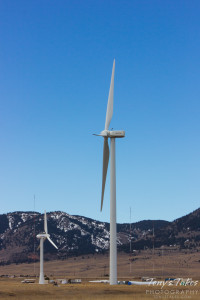When Coloradans flip on their lights or crank up their heat, they expect their electricity to be affordable, and at the very least, reliable. But the state Legislature and Gov. John Hickenlooper are forcing the opposite on Colorado — expensive and unreliable wind energy.
The wind lobby today is one of the fattest hogs at the corporate welfare trough. Rather than win customers through good prices and reliable products, the wind lobby uses political clout to force consumers to purchase its overpriced services. Currently, a state law requires that 12 percent of the state’s electricity be generated by so-called “green” energy. That mandate increases to 20 percent next year, and will jump to 30 percent by 2020 for investor-owned utilities. Senate Bill 252, signed by the governor last year, imposes a 20 percent mandate on rural cooperative electric associations. These jumps will only increase the cost of electricity.
![]() The wind industry is “green” in the sense that it lines its pockets with taxpayer subsidies. The federal $12 billion wind production tax credit was increased to 2.3 cents per kilowatt-hour in 2013. Although Congress decided not to renew this particular form of corporate welfare, the Obama administration has decided to keep the welfare money flowing anyway. The Internal Revenue Service issued guidance that allowed projects under construction and generating electricity by Jan. 1, 2016, to also claim the tax credit, which lasts for 10 years.
The wind industry is “green” in the sense that it lines its pockets with taxpayer subsidies. The federal $12 billion wind production tax credit was increased to 2.3 cents per kilowatt-hour in 2013. Although Congress decided not to renew this particular form of corporate welfare, the Obama administration has decided to keep the welfare money flowing anyway. The Internal Revenue Service issued guidance that allowed projects under construction and generating electricity by Jan. 1, 2016, to also claim the tax credit, which lasts for 10 years.
How dependent is the wind industry on government subsidies? American Wind Energy Association CEO Tom Kiernan pointed to the steep declines in wind capacity installations when the production tax credit is allowed to lapse, as it was briefly at the end of 2012. Last year, total available wind energy output decreased 92 percent.
In other words, almost all the wind power construction today exists only because of taxpayer subsidies. Because the wind lobby has become addicted to corporate welfare, the wind welfare companies have failed to make the technological advances, which make wind power competitive in a free market. It’s easier to lobby Washington to get money extracted from the taxpayers, and to lobby Denver to force consumers to buy your product.

Besides being expensive, wind power is unreliable, as demonstrated by a near-record demand in Texas for home heating in early January, which put a strain on that state’s power grid. The Electric Reliability Council of Texas noted that planned maintenance and unexpected weather-related outages of power plants elsewhere nearly brought on rotating outages.
Proponents declared triumphantly that wind had saved the Texas grid. But in reality, wind had failed.
Put simply, wind energy was unable to fill the gap created by a sudden increase in demand from the cold and the drop in capacity due to the scheduled and unscheduled outages that occurred the morning of Jan. 6. Just as the state experienced a spike in overall energy demand, wind power began to plummet, according to analysis of the council’s data by the Independence Institute.
That morning, wind output fell below 20 percent of maximum capacity by 7 a.m., just as the other power plants went offline. As a percentage of council’s total output, wind fell to below 10 percent and remained there until 11 p.m.
The Institute for Energy Research confirmed that a mere 3.2 percent of the energy supplied to the Texas grid covered by council came from wind. At the moment Texas residents needed reliable power the most, 83 percent of Texas’ wind turbines were unavailable “during peak demand.”
The only thing that saved Texas that day was importing nearly 1,000 megawatts from the eastern power grid and Mexico.
The Comanche Peak 1 nuclear plant fell to 72 percent of capacity on Jan 6. Meanwhile, actual wind output in Texas failed to reach 70 percent during any one hour, and remained below 50 percent in at least 20 of the 24 hours that day.
So when the winter chill hit Texas residents, wind power nearly left them out in the cold. Coloradans would be wise to not endanger their safety in their homes, and their pocketbooks, by forced reliance on an intermittent, subsidy-dependent power source.
Michael Sandoval is an energy policy analyst for the Independence Institute, a free market think tank in Denver.


